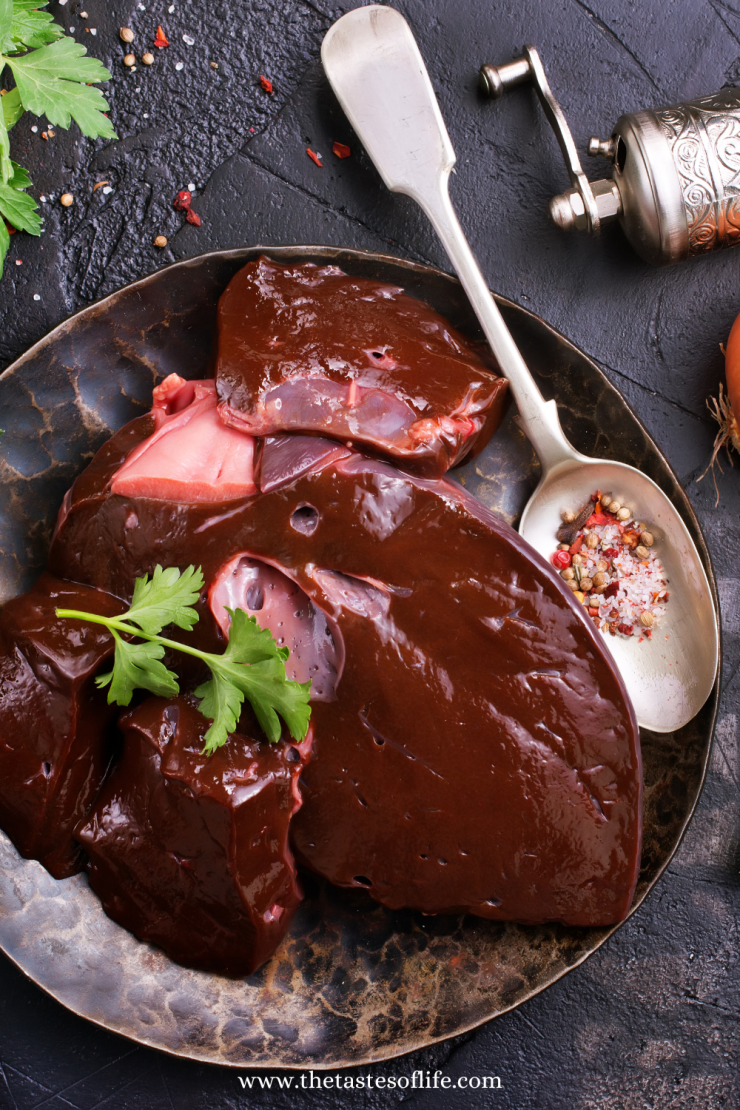Organ Meats: Nutritional Benefits For Hormone Health
Sharing is Caring❤️
Learn what nutritional benefits organ meats have on hormonal balance and health.

Organ Meats: Nutritional Benefits For Hormone Health
In the realm of nutrition, the benefits of organ meats have long been revered by traditional cultures and modern health enthusiasts alike. Often overlooked in favor of more mainstream cuts, these nutrient-dense powerhouses offer many health benefits, particularly regarding hormone health. This comprehensive guide to organ meats nutritional benefits for hormone health delves into the fascinating world of organ meats, the most nutrient-dense foods, and explores their role in optimizing hormonal balance.
Have you ever had an unexpectedly puffy face? Increased sensitivity to hot and cold? What about unexplainable weight gain or loss? Wild mood swings and emotional irrationality?
These are just a few of many signs your hormones could be out of balance. We’ve all heard how important it is to keep your hormones balanced, but how to do that is sometimes a tricky journey of discovery.
What kind of nutrients do you need, and what other moving components play a role in keeping YOUR hormones in proper balance?
Consider this; if your pituitary gland does not get sufficient vitamins D and E or enough Magnesium, it cannot secrete hormones correctly. The pituitary gland is often called the “master gland” because the hormone controls many bodily functions! It creates hormones that enable the proper functioning of the adrenals, thyroid, ovaries, and testes – to name just a few areas influenced.
Suppose your pituitary gland is out of balance. In that case, it will stop your thyroid from producing enough hormones, which can affect metabolism, thus weight gain or loss.
When it comes to hormones, the domino effect comes in full force! Therefore, it is so imperative to balance and support your hormones in every manner possible that is why today you will learn abut organ meats and its nutritional benefits for hormone health

Ancestral Nutrition and Its Effects on Health Today
Research shows that we are ridden with more ailments in modern days and suffer from an ever-growing list of illnesses. These are often diseases that our ancestors did not have to face. If our immune systems are not as hardy as our predecessors, who did not suffer from many chronic diseases, why do we struggle with so many today?
Although the answer to this question undoubtedly has many interpretations, long-time research reveals that diet significantly ensured our ancestors’ good health.
One of the miracle foods that played a massive part in their wellness was grass-fed organ meats. In fact, the level of nutrients in this type of food is even higher than it is in turmeric, kale, and other superfoods like spirulina.
Coming from Poland, I know firsthand how nutritious and essential organ meat is for our health. We used every parts of the animal, and nothing went to waste. Our elders knew the organ meats nutritional benefits for hormone health.
We will take a look at the four basic organ types of organ meat to examine the benefits they have for our hormones. Organ meats are nutrient treasure troves packed with vitamins, minerals, and amino acids that are essential for hormone synthesis and regulation and supporting metabolism, mood, and reproductive health. Then, I will give you a wonderful liver pate recipe.
Health benefits of organ meats
They contain all the essential amino acids, fat-soluble vitamins, folic acid, essential minerals, essential fatty acids, and all important vitamins.
Nutrient Density: Organ meats are incredibly rich in essential vitamins and minerals that are vital for hormone synthesis and regulation. They contain high concentrations of B vitamins (including B12, riboflavin, and folate), A, D, K, iron, zinc, selenium, and copper. These nutrients are crucial in various metabolic pathways in hormone production and function.
Hormone Precursors: Many nutrients found in organ meats serve as precursors or co-factors for hormone synthesis. For example, vitamin A is necessary for producing thyroid hormones. At the same time, zinc synthesizes testosterone and insulin-like growth factor 1 (IGF-1). Consuming organ meats ensures the body has an adequate supply of these essential building blocks for hormone production.
Supports Liver Function: The liver is a rich source of nutrients and plays a central role in hormone metabolism and detoxification. By consuming liver and other organ meats, you provide your body with the nutrients it needs to support optimal liver function, including the breakdown and clearance of hormones and other metabolic byproducts.
Balances Hormone Levels: Organ meats contain nutrients that help balance hormone levels in the body. For example, selenium, found in kidneys and other organ meats, supports thyroid function and helps regulate the production of thyroid hormones. Balanced thyroid function is essential for overall hormone balance and metabolism.
Boosts Energy Levels: Organ meats are dense sources of high-quality protein and iron, crucial for energy production and metabolism. Iron, in particular, is necessary to transport oxygen in the blood and produce energy in cells. Consuming organ meats can help prevent fatigue and support overall energy levels, which is essential for hormone health.
Promotes Tissue Repair and Growth: The amino acids in organ meats, such as glycine and proline, are essential for tissue repair and growth. These amino acids support collagen production, which is necessary for maintaining the health of connective tissues, including skin, bones, and joints. Healthy connective tissues are important for hormone signaling and overall health.
Supports Immune Function: Organ meats contain various nutrients, such as vitamin A, vitamin D, and zinc, that support immune function. A healthy immune system is crucial for overall health. It can indirectly influence hormone balance by reducing inflammation and supporting the body’s ability to cope with stress.

Types of Organ Meats
Here are some common types of organ meats:
- Liver: Liver is perhaps the most well-known organ meat. It is rich in vitamins A, B, and iron. Beef liver, chicken liver, and duck liver are commonly consumed.
- Kidneys: Kidneys filter waste and toxins from the blood and are highly nutritious. They are a good source of protein, vitamin B12, and iron. Beef, lamb, and pork kidneys are commonly eaten.
- Heart: Heart meat is lean and dense, with a distinct flavor. It is rich in protein, iron, zinc, and B vitamins. Beef hearts and chicken hearts are popular choices.
- Tongue: While not technically an organ, the tongue is often considered an offal due to its unique texture and taste. It is high in fat and protein and is enjoyed in various cuisines worldwide.
- Tripe: Tripe is the stomach lining of various animals, including cows, sheep, and pigs. In many cultures, it is often used in soups, stews, and traditional dishes.
- Sweetbreads: Sweetbreads are the thymus or pancreas glands of calves, lambs, or pigs. They have a delicate flavor and tender texture when cooked properly.
- Brains: Brains are rich in healthy fats and are prized for their creamy texture. In some cuisines, they are often used in dishes such as pâtés or fried with eggs.
- Oxtail: While not strictly an organ, oxtail is considered part of the offal category. It refers to the cattle tail and is prized for its rich flavor and gelatinous texture when simmered.
Where Can I Buy Organ Meat?
You can buy organ meats from various sources, including:
- Butcher Shops: Many traditional butcher shops carry a variety of organ meats. They may have liver, kidneys, heart, tongue, and other offal available for purchase. You can ask your local butcher if they have the specific organ meats you want or if they can order them.
- Supermarkets: Some supermarkets carry a selection of organ meats, especially liver and sometimes kidneys. They may be available in the meat department or frozen section. Larger supermarkets or specialty grocery stores are more likely to have a wider variety.
- Ethnic Grocery Stores: Ethnic grocery stores, particularly those catering to specific cuisines like Asian, Latin American, or Middle Eastern, often carry a diverse range of organ meats. In these stores, you may find items like chicken feet, tripe, or pork intestines.
- Farmers’ Markets: Farmers’ markets are a great place to find locally sourced and often organic organ meats. Some farmers raise animals specifically for offal consumption, and you can find various options directly from the producers.
- Online Retailers: Many online retailers specialize in providing high-quality meats, including organ meats. You can find many options from specialty online butcher shops or meat delivery services. Make sure to check the reviews and reputation of the retailer before making a purchase.
- Local Farmer: Some local farms may sell organ meats directly to consumers. You can inquire at nearby farms or search online for farms in your area that offer organ meats for sale.

Liver Meat For Your Hormone Health:
How do the nutrients found in grass-fed liver meat compare with a conventional steak?
You get:
• Four times more iron
• 16 times more vitamin D
• Double the initial amount of selenium
• Five times more vitamin B12
• Almost 5,000 times the amount of vitamin A
A grass-fed beef liver is also the richest provider of REAL Vitamin B12, which can only be found in animal products in abundance.
A deficiency of vitamin B12 can bring hormonal imbalances. If you’ve got too much or too little B12, you may not be able to absorb other vitamins & nutrients. Estrogen is a good example. In a study carried out in 2012, birth control pills can cause a deficiency of vitamin B12, and this, in turn, might cause defective implantation, changes in ovulation, and ultimate infertility.
Vitamin A is the other superstar nutrient any grass-fed liver is known for. Super crucial in numerous biochemical processes throughout your body, Vitamin A is essential in hormone production and healthy thyroid function.
It’s true you get a good amount of Vitamin A as an antioxidant from plant-based foods, yet your body has to convert it before you get many benefits. Vitamin A obtained from animal sources is the best because it offers nutrients that are easily used in their originally bioavailable state.
Kidney Meat for Your Hormone Health:
Kidney meat’s top nutrient gift for you is selenium. (And yes, you’re still looking for grass-fed only!) It has an impressive neuroprotective nature, excellent support for your metabolism, and aids in producing thyroid hormones. Selenium plays a vital role in converting T3 and T4 and, as such, is critical for a properly working thyroid!
Another job of selenium is clearing your body of too much estrogen. It can lead to fibroids, PCOS, endometriosis, and other reproductive disorders if you have too much.
Here’s a list of additional nutrients you’ll get from Kidney meat:
• Copper
• Iron
• Zinc
• Phosphorus
• Vitamin A
• Vitamins B2, B3, B5, B6, B9, and B12

Heart Meat for Your Hormone Health
What’s the world’s leading food source for Copper? Grass-fed beef heart.
Copper is essential in the formation of red blood cells. It helps maintain healthy bones, blood vessels, and nerves and may even prevent cardiovascular disease and osteoporosis.
The most significant health benefit you receive from heart meat is collagen. With high amounts of amino acids, collagen does a great job of balancing hormones. It’s main job is to offset the cortisol imbalance, and as it does so, it balances the HGH, DHEA, Insulin, Progesterone, and melatonin (among others).
And, of course, you get so much more from Heart meat:
• Zinc
• Collagen
• CoQ10
• Copper
Brain Meat For Your Hormone Health
Turn to the brain for one of the richest sources of DHA, EPA, and omega-3 fatty acids. Omega-3s are essential nutrients, crucial for balanced hormones, and the human body doesn’t produce them, so we need to source them in our food.
The brain can also provide neuroprotective nutrients like phosphatidylcholine and phosphatidylserine. Other champion antioxidants you’ll get from brain meat include carotenoids, carnosine, and tocopherols. All these are beneficial in the protection of neurological tissue.
Nutrients & beneficial proteins from Brain meat:
• Omega-3’s
• DHA
• EPA
• phosphatidylcholine
• phosphatidylserine
Saturated Cholesterol and Fats
You may have heard that organ meat has a bunch of cholesterol and saturated fat content. I’m happy to report that this is not a cause for concern, as some have believed. The number of benefits far outweigh any of these claims, and studies done over the past several decades show that both saturated fats and cholesterol are essential for immune function, hormone balance, and neural signaling.
Interestingly enough, since cholesterol is a precursor to the classes of steroid hormones that include progestogens, glucocorticoids, and androgens, our bodies might not produce hormonal balance without cholesterol.
Practical Tips for Incorporating Nutritional Benefits of Organ Meats into Your Diet
Blend Them Into Ground Meats: One of the easiest ways to incorporate organ meats into your diet is by blending them into ground meats. For example, mix finely chopped liver or heart into ground beef, lamb, or turkey when making burgers, meatloaf, or meatballs. The strong flavors of other meats can help mask the taste of organ meats while still providing their nutritional benefits.
Hide Them in Sauces and Stews: Another effective method is to finely chop or puree organ meats and incorporate them into sauces, stews, and chili. The rich flavors of these dishes can help disguise the taste of organ meats while adding depth and nutritional value. For example, add pureed liver to spaghetti sauce or chili for an extra boost of nutrients.
Make Pâtés and Terrines: Pâtés and terrines are delicious ways to enjoy organ meats, as they often include flavorful ingredients like herbs, spices, and aromatics. Blend liver, heart, or kidney with butter, herbs, and garlic to make a tasty pâté that can be spread on toast or crackers. Serve it as an appetizer or snack for a nutrient-rich treat.
Incorporate Them into Soups and Broths: Organ meats can add richness and depth to them, making them more flavorful and nutritious. Add chopped liver, heart, or kidneys to homemade bone broth, vegetables, and herbs for a nourishing soup. The slow cooking process helps soften the texture and mellow the flavor of organ meats.
Mix Them Into Smoothies: While it may sound unconventional, organ meats can be blended into smoothies for a nutrient-packed boost. Combine liver or heart with fruits, vegetables, and other ingredients like yogurt or nut butter to create a creamy and nutritious smoothie. The sweetness of fruits can help mask the taste of organ meats while providing many vitamins and minerals.
Try Different Cooking Methods: Experiment with different cooking methods to find ones that suit your taste preferences. Grilling, roasting, braising, and slow cooking can all yield delicious results with organ meats. For example, braising liver in a flavorful sauce can help tenderize it and enhance its taste, while roasting heart with herbs and spices can impart a rich, savory flavor.
Start Small and Gradually Increase: If you’re new to eating organ meats or find them unappealing, start by incorporating small amounts into your meals and gradually increase the quantity over time. This allows your palate to adjust to the taste and texture of organ meats without overwhelming your senses.
If you don’t want to deal with the texture of organ meats, try Grass-Fed Organ Complex and Ancestral Supplements! They are perfect organ meat supplements. This is a gently freeze-dried powered kind of grass-fed beef liver, kidney, brain, and heart contained within an entirely tasteless capsule.
By being creative and open-minded in the kitchen, you can discover enjoyable ways to incorporate organ meats into your diet, even if you’re not a fan of their taste. With a bit of experimentation and culinary ingenuity, you can reap the nutritional benefits of these nutrient-dense foods while still satisfying your taste buds. I hope that by now you know how to incorporate organ meats and its nutritional benefits for hormone health.
More Food For Hormonal Balance
Eat This One Food for Hormonal Balance
How To Choose Quality Red Meat
References:
https://pubmed.ncbi.nlm.nih.gov/13192509/
https://www.traceminerals.com/blogs/post/the-surprising-health-benefits-of-organ-meats
https://www.healthline.com/nutrition/organ-meats#TOC_TITLE_HDR_4

Liver Pate
Ingredients
- 1 lbs Liver fresh (beef or chicken)
- 1 Onion smal dice
- 2 cloves garlic minced
- 4 tbsp butter you can use olive oil or lard if you allergic to dairy
- 1/4 cup heavy cream use water if you are alleric do dairy
- 2 tbsp brandy or cognac optional
- salt to taste
- black pepper to taste
- 1 tsp thyme fresh, choped
Instructions
- Prepare the Liver: Rinse the liver under cold water and pat dry with paper towels. Remove any connective tissue or membranes.Cut the liver into small pieces for faster cookingSauté Onion and Garlic: In a large skillet, melt 2 tablespoons of butter over medium heat.Add the finely chopped onion and minced garlic to the skillet. Sauté until the onion is translucent and fragrant, about 3-5 minutes.Cook the Liver: Push the onion and garlic to the side of the skillet and add the remaining 2 tablespoons of butter.Increase the heat to medium-high and add the liver pieces to the skillet. Cook until the liver is browned on the outside but still slightly pink on the inside, about 3-4 minutes per side.Deglaze the Skillet (Optional):If using brandy or cognac, carefully add it to the skillet to deglaze the pan. Use a spatula to scrape up any browned bits from the bottom of the skillet. Allow the alcohol to cook off for 1-2 minutes.Blend the Liver Mixture: Transfer the cooked liver, onion, and garlic mixture to a food processor or blender.Add the heavy cream and optional herbs to the food processor.Pulse the mixture until smooth and creamy. You may need to stop and scrape down the sides of the bowl occasionally.Season and Adjust: Taste the liver pâté and season with salt and pepper as needed. Adjust the consistency with more cream if desiredChill and Serve: Transfer the liver pâté to a serving dish or small ramekins.Cover and refrigerate for at least 1-2 hours to allow the flavors to meld and the pâté to set.Serve the liver pâté with crackers, bread, or sliced vegetables as an appetizer or snack.Enjoy your homemade liver pâté! You can store any leftovers in an airtight container in the refrigerator for up to 1 week.






